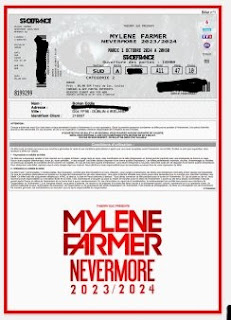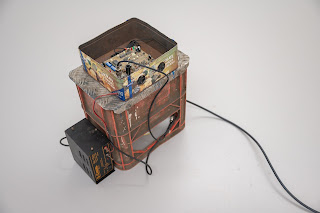On Friday April 14th 2023, the transmitter based in County
Meath, Ireland on 252khz longwave went silent. Its lifetime was colourful and
controversial and while the end was on the agenda for some years, so too was
its beginning. As another analogue service disappears from the airwaves,
perhaps it’s timely to look back at the beginning.
In 1975 RTE, the Irish State broadcaster was awarded the longwave
frequency of 254khz by the International Telecommunications Union. The
frequency lay dormant for over a decade until 1983 when one pirate radio
buccaneer, Chris Cary, the owner of the illegal broadcaster Radio Nova announced
that he was about to launch a longwave station on 254khz based in the former
holiday camp at Mosney announcing it as Radio Exidy. While that venture never
got past a couple of hours of testing, the authorities realised that if a
pirate operator, who’s station was hammering the state broadcaster in the
rating battle, was talking about longwave, maybe there was something in it.

It was fortuitous that the media giant Radio Luxembourg, who’s powerful
208m frequency struggled during daytime hours, was seeking another avenue to
get their product into the important British market. In 1983, discussions began
between RTE and Radio Luxembourg exploring the possibility of using 254khz from
a powerful transmitter located in Ireland broadcasting into Britain. In August
1986 it was announced that the two media companies were forming a company to
broadcast as Radio Tara. The station’s transmitter would be based on lands in
County Meath and initially broadcast from 6am to 7pm daily. One hundred
thousand pounds was used to purchase the land at Summerhill near Trim in County
Meath.

In January 1987, the Department of Posts and Telegraphs granted Radio
Tara Limited, with offices on Fitzwilliam Square, permission to broadcast
without the requirement of new legislation. The opening of the station was part
of the Fianna Fail manifesto for the 1987 General election and was championed
by the new Minister for Posts and Telegraphs Ray Burke. In July 1987, Radio
Tara Limited submitted a planning application for the building of transmitter
housing, a 900ft aerial, taller than the Eiffel Tower and associated
infrastructure including roads to get the station on the air. On October 5th
1987 it was announced that the State’s telecom agency Bord Telecom would be
lodging an objection as they believed the powerful transmitter would cause
problems for the local telephone network. On October 17th, the State
body suddenly without much explanation withdrew their objection, leading to
newspaper speculation that Government pressure had been brought to bear to
force them to withdraw.

The local community immediately objected fearing health issues from the
radiated power of the transmitters. It was a very vocal local protest, which
included all sections of the community. In March 1988 after six hours of
evidence delivered to the planning applications board An Board Pleanala. In
July it was announced that permission had been granted for the erection of the
aerial complex. The Mulhuddard based engineering firm of McInerney’s Civil
Engineering was appointed to build the transmitter base. In August 1988 as the
company began initial construction work, local began protesting at the entrance
halting work until the company won a court injunction to prevent the picketing.
In September newspapers were reporting that the European Investment Bank was
providing Radio Tara Limited with £2.6m in loans to get the station on the air. Radio Tara Limited would be owned 50% by RTE and 50% by Radio
Luxembourg’s parent company. According to subsequent RTE financial reporting,
the national broadcaster invested ir£1,990,207 in getting the station on the
air, with the rest of the estimated ir£8m coming from Luxembourg.


In November 1988 it was announced in London to the media community that
the new station was to be known as Radio Five. In December, the station
announced that Travis Baxter would be appointed the first director of
programming for the station. Up to that point in the UK, there was no national
pop station but the UK Minister responsible Douglas Hurd announced that within
three years national licences would be awarded but this gave the Meath based
station time to get a foothold on both the British listening market and more
importantly the advertising market.

Troubles continued in Summerhill as in January 1989, the site was
sabotaged when sugar was placed in the water tanks used to cool the 300kw
transmitters. Protests continued locally and through the courts with the case
going to the High Court and eventually the Supreme Court. It was reported when
the local council agreed to grant planning permission that they had ignored the
recommendations of their own expert who was against the erection of the
facility. It was widely reported that locals believed and some senior
opposition politicians that Ray Burke as a government minister had put undue
pressure on the local council to allow the station to get on the air. The
Minister denied this at the time but he would be involved in a corruption
scandal involving the awarding of new Independent commercial licences with the
Republic in subsequent years. (See the Flood Tribunal Report)

The studios would be located in a former doctor’s house named Mornington
House in Trim, County Meath. The station also opened a sales office at 74
Newman Street in London. The RTE broadcaster at the time Pat Kenny was appointed chairman of
Radio Tara Limited. In June 1988 it was announced that the new stations name,
after extensive and expensive market research, would be Atlantic 252. This was
despite the initial frequency being 254khz, but the station were aware that in
February 1990, the new frequency allocation to Ireland would alter from 254 to
252khz. At 8am on Friday September 1st 1989, Gary King was the first
voice heard on the new station. The
station beat the first nationally licensed independent commercial station in
the Republic under the new IRTC, Century Radio, by three days. The difference
in the markets try were aiming at is illustrated by the advertising rates
charged by the two stations. On Atlantic 252 a 30sec commercial cost the advertisers
ir£500 (with no regulations on the amount of minutes per hour) while Century
were charging ir£50 for 30sec. Initially
the station was on air from 6am to 7pm and listeners were then invited to tune
into Radio Luxembourg on 208 medium wave. In January 1990 as the station gained
a bigger audience, broadcasting hours were extended to 2am and by the end of
1991, Atlantic 252 was broadcasting 24hours per day.


In its initial years Atlantic 252 struggled to make a profit and
financial pressures on RTE meant that in May 1992, the station sold 30% of
their holding in Radio Tara to RTL for ir£3.85m, making them a 20% minority
shareholder. With RTE’s shareholding significantly reduced the Board Chairman
Pat Kenny was replaced by former Luxembourg Prime Minister Gaston Thorn. By
1995, despite the arrival of national commercial stations in the UK, Atlantic
was winning the ratings battle. 5.8m listening to Atlantic, 4m listening to
Virgin 1215 and 3.73m to Capital Radio. RTE may have regretted selling its
shareholding as in 1995, Atlantic 252 was making a profit, reported in the
trade newspapers as $2m in the first six months of 1995. The Manchester Evening
News once said that,
‘For a while no car ride was complete without hearing
it.’
Atlantic 252 was one of the first champions of an up and coming band in
the late 1990’s, Take That. Despite reaching the heights of over 6m listeners,
the expanding competition on the British mainland from local and national
commercial stations and a reinvigorated BBC, Atlantic’s numbers began to
plateau and then decline. In November 1999 with John O’Hara now at the helm,
the station was relaunched as ‘The New Atlantic 252’ but the slide continued.

October 2001 RTL sold its 80% stake to Teamtalk Radio for €8m. Teamtalk
was based in Leeds but broadcast throughout the UK on 252 from the Clarkstown
transmitter. The final broadcast of Atlantic 252 was on December 20th
2001 and hosted by Enda Cauldwell which celebrated the station’s twelve year
history. Teamtalk 252 was officially opened on March 11th 2002 after
testing from late January and was an all sport radio station. The station
struggled without live rights which were sealed by TalkSport and the BBC and
were relegated to discussion programming and low level live sports coverage. On
July 31st 2002 Teamtalk suddenly closed as its parent company was
sold to a UK betting firm. The result of the sudden demise of the 252 frequency
was that RTE’s bought back the 80% for €630,000

RTE then began rebroadcasting RTE Radio 1 on 252khz aimed at the Irish
diaspora living in the UK estimated at almost six million. The station briefly
broadcast as Charity 252 to coincide with a competition for the 2004 telethon
event ‘People in Need’. According to the Irish Film and Television Network press
release at the time,
This year's
'RTE People in Need Telethon' has a new element. This year mixes radio and
television and will feature seven Irish celebrities locked away in RTE, operating
their own radio station. 'RTE Charity 252' is the radio station that will
commence broadcasting on Friday 14th May, with daily evictions voted for by the
Irish public until the final broadcast on 21 May. Typically, as more
celebrities are evicted, it's up to the remaining DJ's to ensure that the
station continues to transmit.
The
radio broadcasts will be available on the old Atlantic 252 channel, with plenty
of penalties for dead air time, etc. Each evening (9.30-10.30pm), Gerry Ryan
will host a TV eviction programme highlighting the day's events, talking to
contestants, and evicting one celebrity
The
show is being produced by RTE - Niamh Farren is producing the tv show, Alice
O'Sullivan is producing the radio show, and independent production company
Another Avenue (The Restaurant reality TV series) is controlling the
house, providing the edited reality elements for the daily eviction show from
the studio for RTE. Simon Gibney is director.
Philip
Kampff is the overall Executive Producer for RTE People in Need; Patrick Cowap
is on board as the multi-cam director. The seven
women chosen to participate were Sorcha Furlong, Eileen Reid, Amanda Brunker,
Bláthnaid Ní Chofaigh, Fiona McShane, Emma O'Driscoll and Claire McKeon. The last two were Eileen Reid and Fiona McShane are the remaining
contestants. Dublin born showband singer Eileen Reid was the winner of
the show. She ended up getting her own show on RTE Radio 1 as a result of the win
and reaction to her performance on Charity 252.
Initially RTE made a decision to close the frequency in 2014 as a cost
saving exercise, but this postponed following an outcry in Britain from the
Irish listening there. Their ability to listen to RTE had been diminished once
RTE had closed their last medium wave outlet in Tullamore. RTE said that the
cost of running the powerful transmitters was unsustainable that it was
accounting for 2.5% of RTE’s energy bill. It was announced again that the
station would close in 2017 but it was again delayed. Another deadline was set
for 2019 but again delayed as a campaign led by Enda O’Kane, an ex RTE
employee, gained momentum. Some of the issues for the retention of longwave RTE
broadcasts was that manufacturers whether radio or car radio, were not
including longwave as an option anymore. From 2019 there were extended periods
of 252 being off the air for ‘maintenance’ but this was also prepping listeners
to find alternative ways to listen to RTE in the UK.
The Closure came on Friday April 14th 2023, forty years after
Chris Cary of Radio Nova floated the idea of broadcasting from Ireland into
Britain on Longwave.
Personal
For me I miss the original Atlantic 252, I loved listening to the
station in my green Mazda as I travelled to work in Arklow, for others like Enda
O’Kane it’s the severing of their connection to Ireland as they make their way
through life in Britain but the unifying fact is that we miss 252. I miss
Charlie Wolf, the Pizzaman,
Enda Cauldwell, Robin Banks et all. If we can build toll roads and bridges as a public/private partnership. surely there should be a partnership
between public and private enterprise to make all sides happy and bring 252 back
to life.
Pizzaman real name Gary Wilkinson
died aged 50 In October 2022
Sources
The Irish Newspaper Archives
World Radio History
The Irish Broadcasting Hall of Fame
Enda Caudwell
Enda O'Kane
RTE Archives
Atlantic 252 Tribute Site







































